HA 3011 - Advanced Financial Accounting: IFRS, FASB & Regulations
VerifiedAdded on 2023/06/11
|10
|2917
|154
Report
AI Summary
This assignment provides a comprehensive analysis of advanced financial accounting principles, focusing on the application and implications of International Financial Reporting Standards (IFRS) and Financial Accounting Standards Board (FASB) rules. It addresses the qualitative characteristics of financial reporting, examining whether current practices satisfy relevance and faithful representation. The report delves into public interest theory, capture theory, and the economic interest group theory of regulation, evaluating their impact on corporate behavior and government policies. Furthermore, it investigates the implications of FASB rules on the relevance and representational faithfulness of US corporate financial statements, particularly concerning impairment costs. Finally, the assignment explores factors motivating directors' decisions not to revalue property, plant, and equipment, and the subsequent effects on a firm's financial statements. Desklib provides access to similar solved assignments and study resources for students.

Running head: ADVANCED FINANCIAL ACCOUNTING 1
Advanced Financial Accounting
Name
Institution
Advanced Financial Accounting
Name
Institution
Paraphrase This Document
Need a fresh take? Get an instant paraphrase of this document with our AI Paraphraser
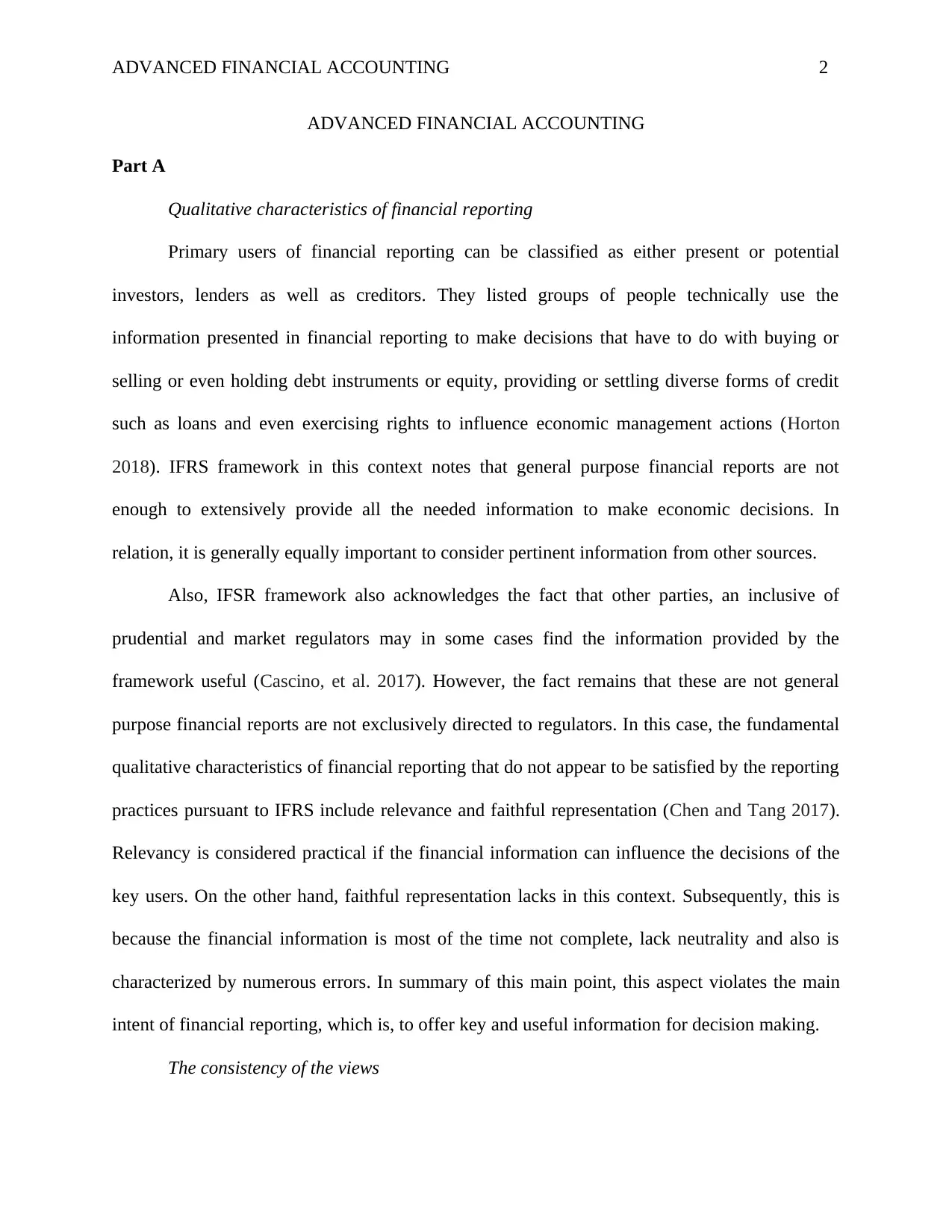
ADVANCED FINANCIAL ACCOUNTING 2
ADVANCED FINANCIAL ACCOUNTING
Part A
Qualitative characteristics of financial reporting
Primary users of financial reporting can be classified as either present or potential
investors, lenders as well as creditors. They listed groups of people technically use the
information presented in financial reporting to make decisions that have to do with buying or
selling or even holding debt instruments or equity, providing or settling diverse forms of credit
such as loans and even exercising rights to influence economic management actions (Horton
2018). IFRS framework in this context notes that general purpose financial reports are not
enough to extensively provide all the needed information to make economic decisions. In
relation, it is generally equally important to consider pertinent information from other sources.
Also, IFSR framework also acknowledges the fact that other parties, an inclusive of
prudential and market regulators may in some cases find the information provided by the
framework useful (Cascino, et al. 2017). However, the fact remains that these are not general
purpose financial reports are not exclusively directed to regulators. In this case, the fundamental
qualitative characteristics of financial reporting that do not appear to be satisfied by the reporting
practices pursuant to IFRS include relevance and faithful representation (Chen and Tang 2017).
Relevancy is considered practical if the financial information can influence the decisions of the
key users. On the other hand, faithful representation lacks in this context. Subsequently, this is
because the financial information is most of the time not complete, lack neutrality and also is
characterized by numerous errors. In summary of this main point, this aspect violates the main
intent of financial reporting, which is, to offer key and useful information for decision making.
The consistency of the views
ADVANCED FINANCIAL ACCOUNTING
Part A
Qualitative characteristics of financial reporting
Primary users of financial reporting can be classified as either present or potential
investors, lenders as well as creditors. They listed groups of people technically use the
information presented in financial reporting to make decisions that have to do with buying or
selling or even holding debt instruments or equity, providing or settling diverse forms of credit
such as loans and even exercising rights to influence economic management actions (Horton
2018). IFRS framework in this context notes that general purpose financial reports are not
enough to extensively provide all the needed information to make economic decisions. In
relation, it is generally equally important to consider pertinent information from other sources.
Also, IFSR framework also acknowledges the fact that other parties, an inclusive of
prudential and market regulators may in some cases find the information provided by the
framework useful (Cascino, et al. 2017). However, the fact remains that these are not general
purpose financial reports are not exclusively directed to regulators. In this case, the fundamental
qualitative characteristics of financial reporting that do not appear to be satisfied by the reporting
practices pursuant to IFRS include relevance and faithful representation (Chen and Tang 2017).
Relevancy is considered practical if the financial information can influence the decisions of the
key users. On the other hand, faithful representation lacks in this context. Subsequently, this is
because the financial information is most of the time not complete, lack neutrality and also is
characterized by numerous errors. In summary of this main point, this aspect violates the main
intent of financial reporting, which is, to offer key and useful information for decision making.
The consistency of the views
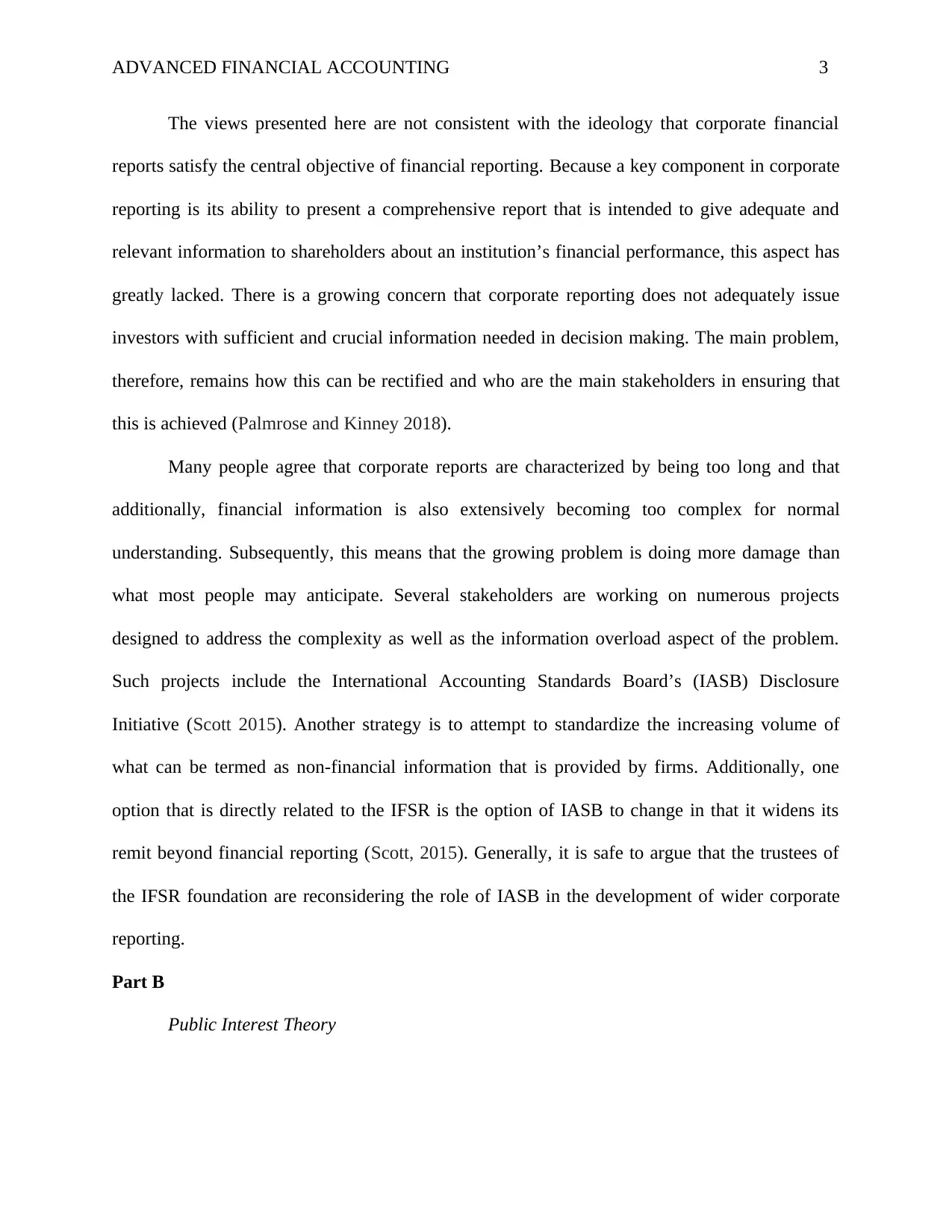
ADVANCED FINANCIAL ACCOUNTING 3
The views presented here are not consistent with the ideology that corporate financial
reports satisfy the central objective of financial reporting. Because a key component in corporate
reporting is its ability to present a comprehensive report that is intended to give adequate and
relevant information to shareholders about an institution’s financial performance, this aspect has
greatly lacked. There is a growing concern that corporate reporting does not adequately issue
investors with sufficient and crucial information needed in decision making. The main problem,
therefore, remains how this can be rectified and who are the main stakeholders in ensuring that
this is achieved (Palmrose and Kinney 2018).
Many people agree that corporate reports are characterized by being too long and that
additionally, financial information is also extensively becoming too complex for normal
understanding. Subsequently, this means that the growing problem is doing more damage than
what most people may anticipate. Several stakeholders are working on numerous projects
designed to address the complexity as well as the information overload aspect of the problem.
Such projects include the International Accounting Standards Board’s (IASB) Disclosure
Initiative (Scott 2015). Another strategy is to attempt to standardize the increasing volume of
what can be termed as non-financial information that is provided by firms. Additionally, one
option that is directly related to the IFSR is the option of IASB to change in that it widens its
remit beyond financial reporting (Scott, 2015). Generally, it is safe to argue that the trustees of
the IFSR foundation are reconsidering the role of IASB in the development of wider corporate
reporting.
Part B
Public Interest Theory
The views presented here are not consistent with the ideology that corporate financial
reports satisfy the central objective of financial reporting. Because a key component in corporate
reporting is its ability to present a comprehensive report that is intended to give adequate and
relevant information to shareholders about an institution’s financial performance, this aspect has
greatly lacked. There is a growing concern that corporate reporting does not adequately issue
investors with sufficient and crucial information needed in decision making. The main problem,
therefore, remains how this can be rectified and who are the main stakeholders in ensuring that
this is achieved (Palmrose and Kinney 2018).
Many people agree that corporate reports are characterized by being too long and that
additionally, financial information is also extensively becoming too complex for normal
understanding. Subsequently, this means that the growing problem is doing more damage than
what most people may anticipate. Several stakeholders are working on numerous projects
designed to address the complexity as well as the information overload aspect of the problem.
Such projects include the International Accounting Standards Board’s (IASB) Disclosure
Initiative (Scott 2015). Another strategy is to attempt to standardize the increasing volume of
what can be termed as non-financial information that is provided by firms. Additionally, one
option that is directly related to the IFSR is the option of IASB to change in that it widens its
remit beyond financial reporting (Scott, 2015). Generally, it is safe to argue that the trustees of
the IFSR foundation are reconsidering the role of IASB in the development of wider corporate
reporting.
Part B
Public Interest Theory
⊘ This is a preview!⊘
Do you want full access?
Subscribe today to unlock all pages.

Trusted by 1+ million students worldwide

ADVANCED FINANCIAL ACCOUNTING 4
The Australian government is technically justified in its argument that no specific
regulations should be added to the legislation. On the contrary, the market forces are extensively
more important and more influential in advocating for companies to do the right thing
(Mansbridge, 2018). In the same perspective, the public interest theory affirms the same claims
made by the government. Relatively, the theory is an economic concept that is strongly
associated with Welfare economics. The theory basically provides theoretical justifications for
regulations. The market, in this case, is characterized by certain features, including externalities,
imperfect competition, and asymmetric information (Berry and Wilcox 2018).
Regulators, in this case, are motivated by societal interests. In relation, they intervene in
the market to improve social outcomes related to the same. With the interest of the society at
heart, it is most likely that institutions will engage in environmentally friendly projects as well as
programs that work towards the benefit of the entire society. The government or even policies in
the form of regulations will not, therefore, act as the watchdog appointed to ensure that
companies do the right thing. On the contrary, firms will be self-directed hence will act as a very
important institution in public development which in turn is very essential (Grunig 2017).
Capture Theory
Capture theory in financial regulation is another very significant and essential topic. In
the same measure, capture theory and regulation point out that regulations are manipulated to fit
the expectations as well as requirements of those who are directly affected by the said
regulations. The theory was first pinned by Hertog, a political scientist (Henderson 2017). The
primary advantage of this theory, by the case study, is the fact that it clearly explains the main
motive behind designing regulations. In this case, there will be the extensive participation of all
the involved stakeholders, stretching from the consumers, the companies involved and even,
The Australian government is technically justified in its argument that no specific
regulations should be added to the legislation. On the contrary, the market forces are extensively
more important and more influential in advocating for companies to do the right thing
(Mansbridge, 2018). In the same perspective, the public interest theory affirms the same claims
made by the government. Relatively, the theory is an economic concept that is strongly
associated with Welfare economics. The theory basically provides theoretical justifications for
regulations. The market, in this case, is characterized by certain features, including externalities,
imperfect competition, and asymmetric information (Berry and Wilcox 2018).
Regulators, in this case, are motivated by societal interests. In relation, they intervene in
the market to improve social outcomes related to the same. With the interest of the society at
heart, it is most likely that institutions will engage in environmentally friendly projects as well as
programs that work towards the benefit of the entire society. The government or even policies in
the form of regulations will not, therefore, act as the watchdog appointed to ensure that
companies do the right thing. On the contrary, firms will be self-directed hence will act as a very
important institution in public development which in turn is very essential (Grunig 2017).
Capture Theory
Capture theory in financial regulation is another very significant and essential topic. In
the same measure, capture theory and regulation point out that regulations are manipulated to fit
the expectations as well as requirements of those who are directly affected by the said
regulations. The theory was first pinned by Hertog, a political scientist (Henderson 2017). The
primary advantage of this theory, by the case study, is the fact that it clearly explains the main
motive behind designing regulations. In this case, there will be the extensive participation of all
the involved stakeholders, stretching from the consumers, the companies involved and even,
Paraphrase This Document
Need a fresh take? Get an instant paraphrase of this document with our AI Paraphraser
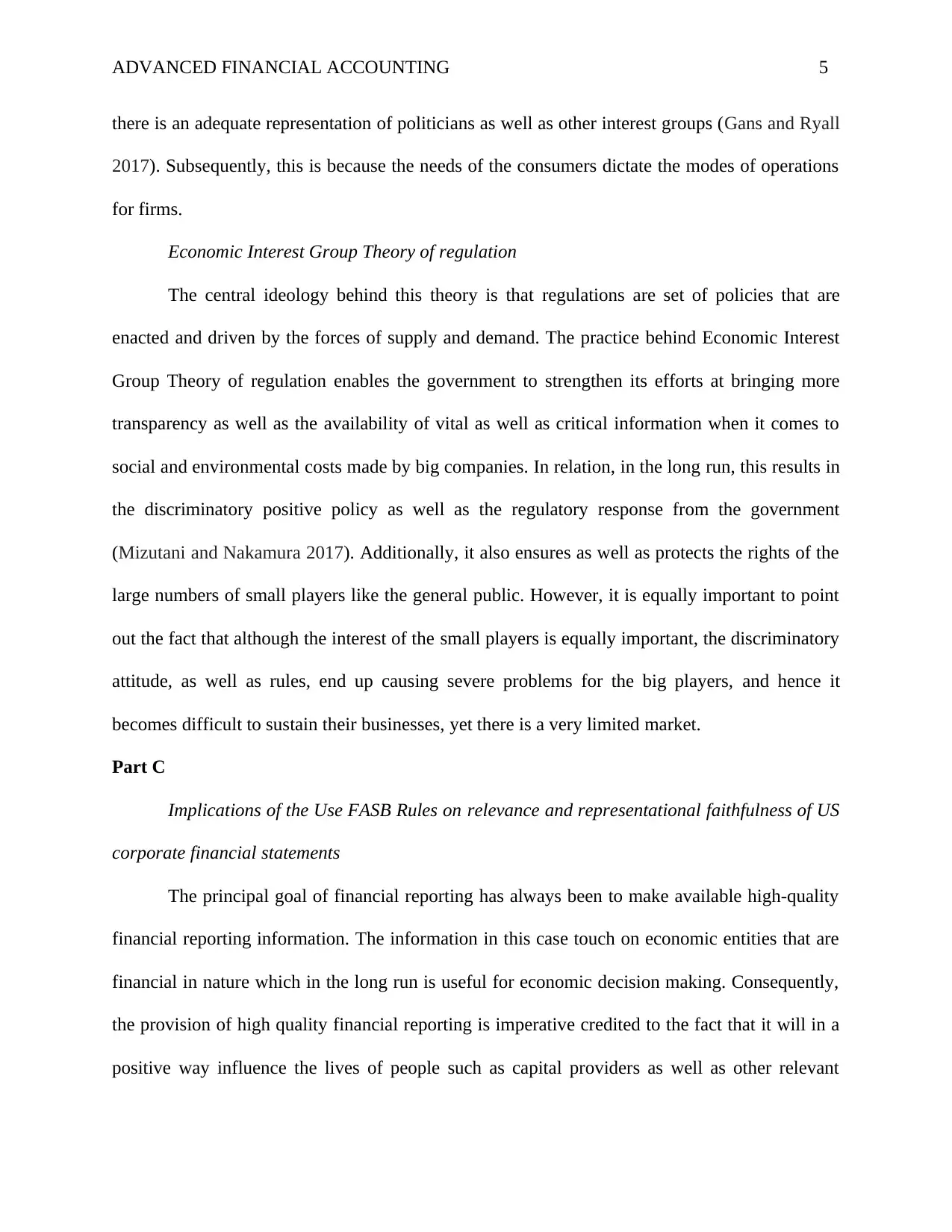
ADVANCED FINANCIAL ACCOUNTING 5
there is an adequate representation of politicians as well as other interest groups (Gans and Ryall
2017). Subsequently, this is because the needs of the consumers dictate the modes of operations
for firms.
Economic Interest Group Theory of regulation
The central ideology behind this theory is that regulations are set of policies that are
enacted and driven by the forces of supply and demand. The practice behind Economic Interest
Group Theory of regulation enables the government to strengthen its efforts at bringing more
transparency as well as the availability of vital as well as critical information when it comes to
social and environmental costs made by big companies. In relation, in the long run, this results in
the discriminatory positive policy as well as the regulatory response from the government
(Mizutani and Nakamura 2017). Additionally, it also ensures as well as protects the rights of the
large numbers of small players like the general public. However, it is equally important to point
out the fact that although the interest of the small players is equally important, the discriminatory
attitude, as well as rules, end up causing severe problems for the big players, and hence it
becomes difficult to sustain their businesses, yet there is a very limited market.
Part C
Implications of the Use FASB Rules on relevance and representational faithfulness of US
corporate financial statements
The principal goal of financial reporting has always been to make available high-quality
financial reporting information. The information in this case touch on economic entities that are
financial in nature which in the long run is useful for economic decision making. Consequently,
the provision of high quality financial reporting is imperative credited to the fact that it will in a
positive way influence the lives of people such as capital providers as well as other relevant
there is an adequate representation of politicians as well as other interest groups (Gans and Ryall
2017). Subsequently, this is because the needs of the consumers dictate the modes of operations
for firms.
Economic Interest Group Theory of regulation
The central ideology behind this theory is that regulations are set of policies that are
enacted and driven by the forces of supply and demand. The practice behind Economic Interest
Group Theory of regulation enables the government to strengthen its efforts at bringing more
transparency as well as the availability of vital as well as critical information when it comes to
social and environmental costs made by big companies. In relation, in the long run, this results in
the discriminatory positive policy as well as the regulatory response from the government
(Mizutani and Nakamura 2017). Additionally, it also ensures as well as protects the rights of the
large numbers of small players like the general public. However, it is equally important to point
out the fact that although the interest of the small players is equally important, the discriminatory
attitude, as well as rules, end up causing severe problems for the big players, and hence it
becomes difficult to sustain their businesses, yet there is a very limited market.
Part C
Implications of the Use FASB Rules on relevance and representational faithfulness of US
corporate financial statements
The principal goal of financial reporting has always been to make available high-quality
financial reporting information. The information in this case touch on economic entities that are
financial in nature which in the long run is useful for economic decision making. Consequently,
the provision of high quality financial reporting is imperative credited to the fact that it will in a
positive way influence the lives of people such as capital providers as well as other relevant
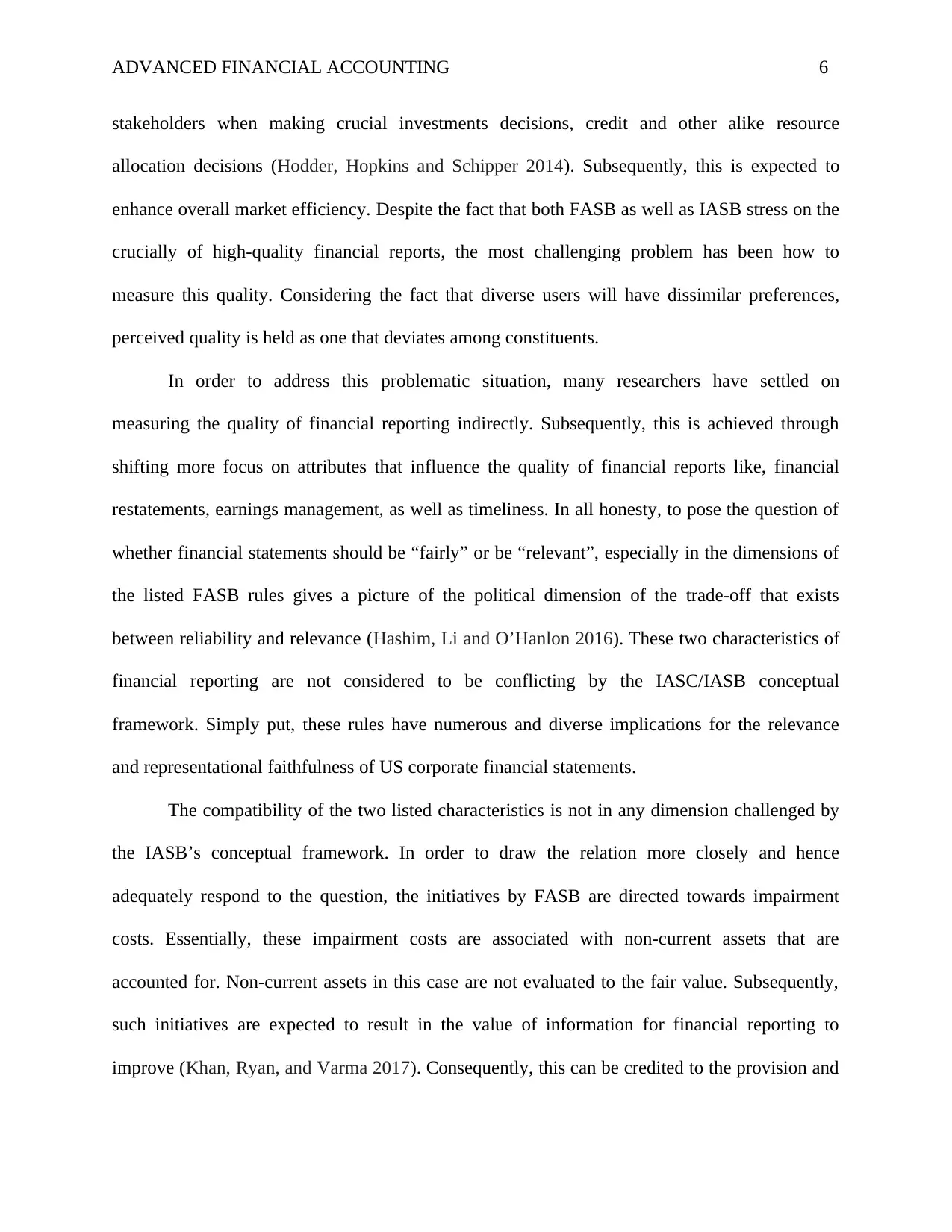
ADVANCED FINANCIAL ACCOUNTING 6
stakeholders when making crucial investments decisions, credit and other alike resource
allocation decisions (Hodder, Hopkins and Schipper 2014). Subsequently, this is expected to
enhance overall market efficiency. Despite the fact that both FASB as well as IASB stress on the
crucially of high-quality financial reports, the most challenging problem has been how to
measure this quality. Considering the fact that diverse users will have dissimilar preferences,
perceived quality is held as one that deviates among constituents.
In order to address this problematic situation, many researchers have settled on
measuring the quality of financial reporting indirectly. Subsequently, this is achieved through
shifting more focus on attributes that influence the quality of financial reports like, financial
restatements, earnings management, as well as timeliness. In all honesty, to pose the question of
whether financial statements should be “fairly” or be “relevant”, especially in the dimensions of
the listed FASB rules gives a picture of the political dimension of the trade-off that exists
between reliability and relevance (Hashim, Li and O’Hanlon 2016). These two characteristics of
financial reporting are not considered to be conflicting by the IASC/IASB conceptual
framework. Simply put, these rules have numerous and diverse implications for the relevance
and representational faithfulness of US corporate financial statements.
The compatibility of the two listed characteristics is not in any dimension challenged by
the IASB’s conceptual framework. In order to draw the relation more closely and hence
adequately respond to the question, the initiatives by FASB are directed towards impairment
costs. Essentially, these impairment costs are associated with non-current assets that are
accounted for. Non-current assets in this case are not evaluated to the fair value. Subsequently,
such initiatives are expected to result in the value of information for financial reporting to
improve (Khan, Ryan, and Varma 2017). Consequently, this can be credited to the provision and
stakeholders when making crucial investments decisions, credit and other alike resource
allocation decisions (Hodder, Hopkins and Schipper 2014). Subsequently, this is expected to
enhance overall market efficiency. Despite the fact that both FASB as well as IASB stress on the
crucially of high-quality financial reports, the most challenging problem has been how to
measure this quality. Considering the fact that diverse users will have dissimilar preferences,
perceived quality is held as one that deviates among constituents.
In order to address this problematic situation, many researchers have settled on
measuring the quality of financial reporting indirectly. Subsequently, this is achieved through
shifting more focus on attributes that influence the quality of financial reports like, financial
restatements, earnings management, as well as timeliness. In all honesty, to pose the question of
whether financial statements should be “fairly” or be “relevant”, especially in the dimensions of
the listed FASB rules gives a picture of the political dimension of the trade-off that exists
between reliability and relevance (Hashim, Li and O’Hanlon 2016). These two characteristics of
financial reporting are not considered to be conflicting by the IASC/IASB conceptual
framework. Simply put, these rules have numerous and diverse implications for the relevance
and representational faithfulness of US corporate financial statements.
The compatibility of the two listed characteristics is not in any dimension challenged by
the IASB’s conceptual framework. In order to draw the relation more closely and hence
adequately respond to the question, the initiatives by FASB are directed towards impairment
costs. Essentially, these impairment costs are associated with non-current assets that are
accounted for. Non-current assets in this case are not evaluated to the fair value. Subsequently,
such initiatives are expected to result in the value of information for financial reporting to
improve (Khan, Ryan, and Varma 2017). Consequently, this can be credited to the provision and
⊘ This is a preview!⊘
Do you want full access?
Subscribe today to unlock all pages.

Trusted by 1+ million students worldwide

ADVANCED FINANCIAL ACCOUNTING 7
availability of relevant information. Therefore, this model allows financial information to be of
the needed credibility in terms of relevancy hence can be used in critical decision-making
decisions the investors. The key lesson in terms of the underlying ideology in this case is the
argument that a comprehensive measurement tool should be based on the quality of financial
reporting in terms of its qualitative characteristics, that is: relevance and faithful representation.
In addition, it is equally important to enhance qualitative characteristics such as: verifiability,
comparability, understandability and timeliness because that is where the power lies.
Part D
Factors the motivate directors not to revalue the property, plant, and equipment
This section will examine one crucial factor that has been termed as a primary driving
force which motivate directors not to revalue property, plant, and equipment. Revaluation simply
puts means the act of recognizing a reassessment of the carrying amount of an asset that can be
considered as non-current to its fair value at a given date. However, this is an exclusion of
recoverable amount write-downs as well as impairment losses (Islam, Nusrat, and Karim 2016).
Revaluation of fixed assets can be classified as either upward or downward. In this sense,
upward revaluation increases the value of fixed assets as well as shareholder equity or also, has
the potential to reduce financial leverage ratios. In connection, property, plant, as well as
equipment, is categorized as Non-current assets. Generally, one of the most significant
drawbacks of revaluation includes the cost involved in the process of revaluation. Ultimately,
these costs result in an increase in expenses which eventually leads to reduced cash flow as well
as fall in net profits.
Effects the decision not to revalue on the firm’s financial statements
availability of relevant information. Therefore, this model allows financial information to be of
the needed credibility in terms of relevancy hence can be used in critical decision-making
decisions the investors. The key lesson in terms of the underlying ideology in this case is the
argument that a comprehensive measurement tool should be based on the quality of financial
reporting in terms of its qualitative characteristics, that is: relevance and faithful representation.
In addition, it is equally important to enhance qualitative characteristics such as: verifiability,
comparability, understandability and timeliness because that is where the power lies.
Part D
Factors the motivate directors not to revalue the property, plant, and equipment
This section will examine one crucial factor that has been termed as a primary driving
force which motivate directors not to revalue property, plant, and equipment. Revaluation simply
puts means the act of recognizing a reassessment of the carrying amount of an asset that can be
considered as non-current to its fair value at a given date. However, this is an exclusion of
recoverable amount write-downs as well as impairment losses (Islam, Nusrat, and Karim 2016).
Revaluation of fixed assets can be classified as either upward or downward. In this sense,
upward revaluation increases the value of fixed assets as well as shareholder equity or also, has
the potential to reduce financial leverage ratios. In connection, property, plant, as well as
equipment, is categorized as Non-current assets. Generally, one of the most significant
drawbacks of revaluation includes the cost involved in the process of revaluation. Ultimately,
these costs result in an increase in expenses which eventually leads to reduced cash flow as well
as fall in net profits.
Effects the decision not to revalue on the firm’s financial statements
Paraphrase This Document
Need a fresh take? Get an instant paraphrase of this document with our AI Paraphraser

ADVANCED FINANCIAL ACCOUNTING 8
Revaluation of assets is considered very crucial in finance because it is used to compute
the true values of assets owned by a firm. It is therefore considered very important to
acknowledge the fact that the decisions not to revalue have devastating effects on a firm’s
financial statement (Malmendier, Opp, and Saidi 2016). Long-lived assets can be categorized
into three: tangible assets like plant, property and equipment, identifiable assets such as license
and non-identifiable intangible assets like goodwill of the company. Failing to revalue therefore
means failing to determine the actual rate of return on capital, failure to determine the fair market
value following a huge appreciation since the initial purchase, as well as the lack of the ability to
negotiate proper pricing for an asset in the event of a merger or acquisition. Simply put,
revaluation affects financial statements in the following listed ways:
Increase in book value of the asset, reducing net income
The decrease in the carrying amount resulting in the decline of ROA and ROE
In a downward revaluation, credited to lower total assets as well as equity,
profitability tends to increase in future years.
In summary of this main point. Revaluation is a crucial accounting decision in any firm
because it impacts numerous financial statements. Firms that follow IFRS should, therefore,
undergo revaluation diligently.
The effects of the decision of not to revalue
The decision not to revalue will adversely affect the wealth of the shareholders in the
long run credited to some of the factors listed above. The central argument remains the fact that
revaluation models provide companies with a realistic presentation of their financial statement
(Gray, Jorge, and Rodriguez 2015). Subsequently, this is because it allows for the presentation of
Revaluation of assets is considered very crucial in finance because it is used to compute
the true values of assets owned by a firm. It is therefore considered very important to
acknowledge the fact that the decisions not to revalue have devastating effects on a firm’s
financial statement (Malmendier, Opp, and Saidi 2016). Long-lived assets can be categorized
into three: tangible assets like plant, property and equipment, identifiable assets such as license
and non-identifiable intangible assets like goodwill of the company. Failing to revalue therefore
means failing to determine the actual rate of return on capital, failure to determine the fair market
value following a huge appreciation since the initial purchase, as well as the lack of the ability to
negotiate proper pricing for an asset in the event of a merger or acquisition. Simply put,
revaluation affects financial statements in the following listed ways:
Increase in book value of the asset, reducing net income
The decrease in the carrying amount resulting in the decline of ROA and ROE
In a downward revaluation, credited to lower total assets as well as equity,
profitability tends to increase in future years.
In summary of this main point. Revaluation is a crucial accounting decision in any firm
because it impacts numerous financial statements. Firms that follow IFRS should, therefore,
undergo revaluation diligently.
The effects of the decision of not to revalue
The decision not to revalue will adversely affect the wealth of the shareholders in the
long run credited to some of the factors listed above. The central argument remains the fact that
revaluation models provide companies with a realistic presentation of their financial statement
(Gray, Jorge, and Rodriguez 2015). Subsequently, this is because it allows for the presentation of
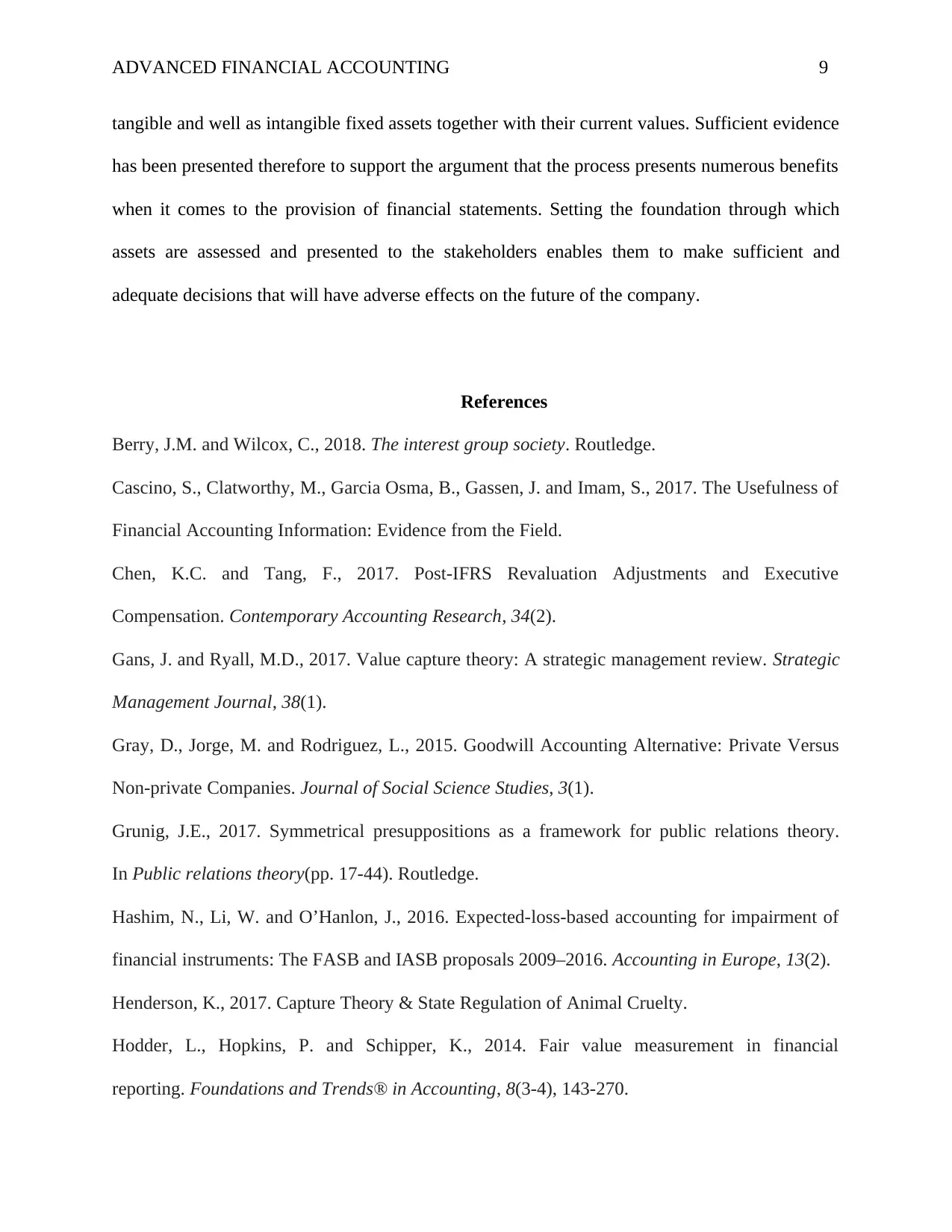
ADVANCED FINANCIAL ACCOUNTING 9
tangible and well as intangible fixed assets together with their current values. Sufficient evidence
has been presented therefore to support the argument that the process presents numerous benefits
when it comes to the provision of financial statements. Setting the foundation through which
assets are assessed and presented to the stakeholders enables them to make sufficient and
adequate decisions that will have adverse effects on the future of the company.
References
Berry, J.M. and Wilcox, C., 2018. The interest group society. Routledge.
Cascino, S., Clatworthy, M., Garcia Osma, B., Gassen, J. and Imam, S., 2017. The Usefulness of
Financial Accounting Information: Evidence from the Field.
Chen, K.C. and Tang, F., 2017. Post‐IFRS Revaluation Adjustments and Executive
Compensation. Contemporary Accounting Research, 34(2).
Gans, J. and Ryall, M.D., 2017. Value capture theory: A strategic management review. Strategic
Management Journal, 38(1).
Gray, D., Jorge, M. and Rodriguez, L., 2015. Goodwill Accounting Alternative: Private Versus
Non-private Companies. Journal of Social Science Studies, 3(1).
Grunig, J.E., 2017. Symmetrical presuppositions as a framework for public relations theory.
In Public relations theory(pp. 17-44). Routledge.
Hashim, N., Li, W. and O’Hanlon, J., 2016. Expected-loss-based accounting for impairment of
financial instruments: The FASB and IASB proposals 2009–2016. Accounting in Europe, 13(2).
Henderson, K., 2017. Capture Theory & State Regulation of Animal Cruelty.
Hodder, L., Hopkins, P. and Schipper, K., 2014. Fair value measurement in financial
reporting. Foundations and Trends® in Accounting, 8(3-4), 143-270.
tangible and well as intangible fixed assets together with their current values. Sufficient evidence
has been presented therefore to support the argument that the process presents numerous benefits
when it comes to the provision of financial statements. Setting the foundation through which
assets are assessed and presented to the stakeholders enables them to make sufficient and
adequate decisions that will have adverse effects on the future of the company.
References
Berry, J.M. and Wilcox, C., 2018. The interest group society. Routledge.
Cascino, S., Clatworthy, M., Garcia Osma, B., Gassen, J. and Imam, S., 2017. The Usefulness of
Financial Accounting Information: Evidence from the Field.
Chen, K.C. and Tang, F., 2017. Post‐IFRS Revaluation Adjustments and Executive
Compensation. Contemporary Accounting Research, 34(2).
Gans, J. and Ryall, M.D., 2017. Value capture theory: A strategic management review. Strategic
Management Journal, 38(1).
Gray, D., Jorge, M. and Rodriguez, L., 2015. Goodwill Accounting Alternative: Private Versus
Non-private Companies. Journal of Social Science Studies, 3(1).
Grunig, J.E., 2017. Symmetrical presuppositions as a framework for public relations theory.
In Public relations theory(pp. 17-44). Routledge.
Hashim, N., Li, W. and O’Hanlon, J., 2016. Expected-loss-based accounting for impairment of
financial instruments: The FASB and IASB proposals 2009–2016. Accounting in Europe, 13(2).
Henderson, K., 2017. Capture Theory & State Regulation of Animal Cruelty.
Hodder, L., Hopkins, P. and Schipper, K., 2014. Fair value measurement in financial
reporting. Foundations and Trends® in Accounting, 8(3-4), 143-270.
⊘ This is a preview!⊘
Do you want full access?
Subscribe today to unlock all pages.

Trusted by 1+ million students worldwide
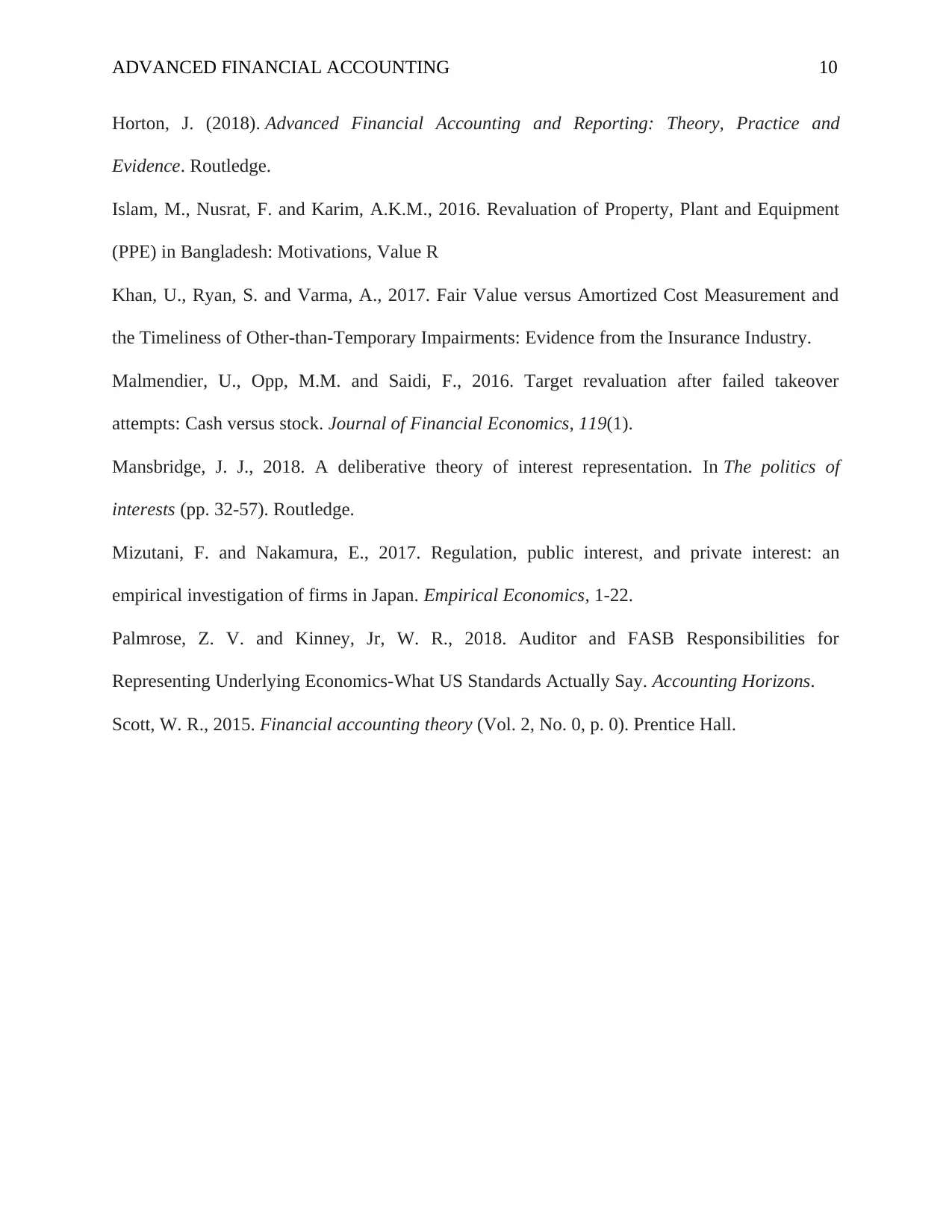
ADVANCED FINANCIAL ACCOUNTING 10
Horton, J. (2018). Advanced Financial Accounting and Reporting: Theory, Practice and
Evidence. Routledge.
Islam, M., Nusrat, F. and Karim, A.K.M., 2016. Revaluation of Property, Plant and Equipment
(PPE) in Bangladesh: Motivations, Value R
Khan, U., Ryan, S. and Varma, A., 2017. Fair Value versus Amortized Cost Measurement and
the Timeliness of Other-than-Temporary Impairments: Evidence from the Insurance Industry.
Malmendier, U., Opp, M.M. and Saidi, F., 2016. Target revaluation after failed takeover
attempts: Cash versus stock. Journal of Financial Economics, 119(1).
Mansbridge, J. J., 2018. A deliberative theory of interest representation. In The politics of
interests (pp. 32-57). Routledge.
Mizutani, F. and Nakamura, E., 2017. Regulation, public interest, and private interest: an
empirical investigation of firms in Japan. Empirical Economics, 1-22.
Palmrose, Z. V. and Kinney, Jr, W. R., 2018. Auditor and FASB Responsibilities for
Representing Underlying Economics-What US Standards Actually Say. Accounting Horizons.
Scott, W. R., 2015. Financial accounting theory (Vol. 2, No. 0, p. 0). Prentice Hall.
Horton, J. (2018). Advanced Financial Accounting and Reporting: Theory, Practice and
Evidence. Routledge.
Islam, M., Nusrat, F. and Karim, A.K.M., 2016. Revaluation of Property, Plant and Equipment
(PPE) in Bangladesh: Motivations, Value R
Khan, U., Ryan, S. and Varma, A., 2017. Fair Value versus Amortized Cost Measurement and
the Timeliness of Other-than-Temporary Impairments: Evidence from the Insurance Industry.
Malmendier, U., Opp, M.M. and Saidi, F., 2016. Target revaluation after failed takeover
attempts: Cash versus stock. Journal of Financial Economics, 119(1).
Mansbridge, J. J., 2018. A deliberative theory of interest representation. In The politics of
interests (pp. 32-57). Routledge.
Mizutani, F. and Nakamura, E., 2017. Regulation, public interest, and private interest: an
empirical investigation of firms in Japan. Empirical Economics, 1-22.
Palmrose, Z. V. and Kinney, Jr, W. R., 2018. Auditor and FASB Responsibilities for
Representing Underlying Economics-What US Standards Actually Say. Accounting Horizons.
Scott, W. R., 2015. Financial accounting theory (Vol. 2, No. 0, p. 0). Prentice Hall.
1 out of 10
Related Documents
Your All-in-One AI-Powered Toolkit for Academic Success.
+13062052269
info@desklib.com
Available 24*7 on WhatsApp / Email
![[object Object]](/_next/static/media/star-bottom.7253800d.svg)
Unlock your academic potential
Copyright © 2020–2025 A2Z Services. All Rights Reserved. Developed and managed by ZUCOL.





